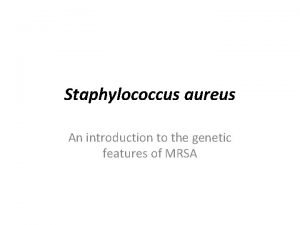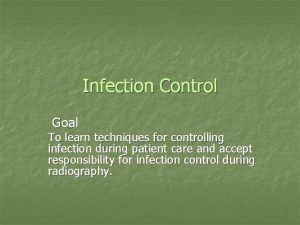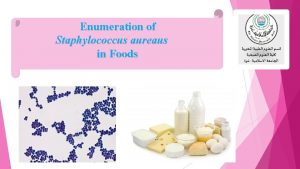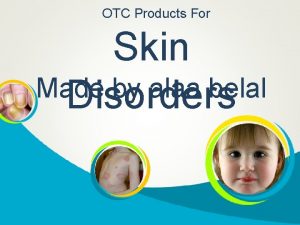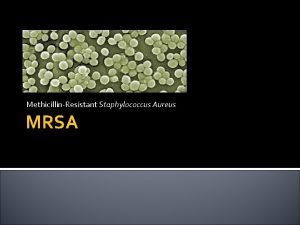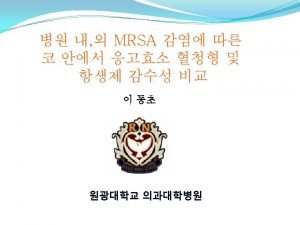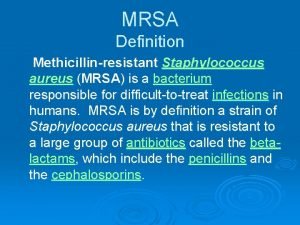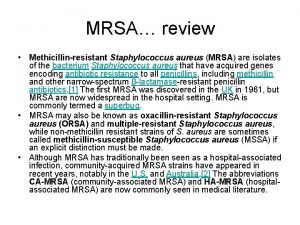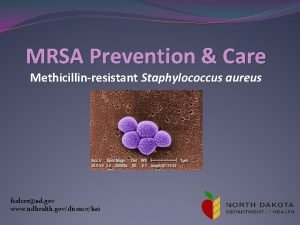MRSA What is MRSA Methicillinresistant Staphylococcus aureus MRSA









- Slides: 9

MRSA

What is MRSA? • Methicillin-resistant Staphylococcus aureus (MRSA) – A strain of staphylococcus aureus - also called “staph” MRSA is a bacterium that causes infections in different parts of the body – The symptoms of MRSA depend on where you're infected, but most often it causes mild infections on the skin, causing pimples or boils – It can also cause more serious skin infections or infect surgical wounds, the bloodstream, the lungs, or the urinary tract – Though most MRSA infections aren't serious, some can be life-threatening

What is MRSA? • Garden-variety staph are common bacteria that can live on our bodies. – Plenty of healthy people carry staph without being infected by it. In fact, 25 -30% of us have staph bacteria in our noses – But staph can be a problem if it manages to get into the body, often through a cut. Once there, it can cause an infection – Staph is one of the most common causes of skin infections in the U. S.

What is MRSA? • It's tougher to treat than most strains of staph – Over the decades, some strains of staph -- like MRSA -have become resistant to antibiotics that once destroyed it – MRSA, first discovered in 1961, is now immune to methicillin, amoxicillin, penicillin, oxacillin, and many other antibiotics – While some antibiotics still work, MRSA is constantly adapting. – Researchers developing new antibiotics are having a tough time keeping up.

Who Gets MRSA? • MRSA is spread by contact – You could get MRSA by touching another person who has it on their skin, or you could get it by touching objects that have the bacteria on them – MRSA is carried, or "colonized, " by about 1% of the population, although most of them aren't infected – Infections are most common among people who have weak immune systems and are living in hospitals, nursing homes, and other health care centers

Who Gets MRSA? • Community-Associated MRSA (CA-MRSA) – MRSA is also showing up in healthy people who have not been living in the hospital – This type of MRSA is called community-associated MRSA, or CA-MRSA – The CDC reports that in 2003, 12% of people with MRSA infections had CA-MRSA – Rates of MRSA infection are rising. In U. S. hospitals, MRSA causes up to 40%-50% of staph infections

How do you fight it? There are several things you should be doing to minimize the risk of CA-MRSA infections in your facility: – MRSA Prevention Education Programs – Hand Washing Programs – Cleaning program utilizing good infection control procedures – Provide high quality, environmentally preferable products for your cleaning and hand washing programs

Symptoms of MRSA • MRSA most often appears as a skin infection, like a boil or abscess. Many people who actually have staph skin infections often mistake it for a spider bite. – The infected area would look: • Swollen, Red, Painful, Puss-filled – If staph infects the lungs and causes pneumonia, you might have: • Shortness of breath, Fever, Chills

Hand Washing Programs Implement a Hand Washing initiative and training program for your building occupants. The first line of defense against the spread of any infectious disease is proper and frequent hand washing. – Educate your building occupants on the benefits of hand washing and proper hand washing technique regularly – Use posters as a reminder – Make waterless hand sanitizers available in situations where washing with soap and water is not likely to happen
 Conjugation reproduction
Conjugation reproduction Are red blood cells prokaryotic
Are red blood cells prokaryotic Staphylococcus gamma hemolysis
Staphylococcus gamma hemolysis Enzymes of staphylococcus aureus
Enzymes of staphylococcus aureus Difference between differential and selective media
Difference between differential and selective media Staphylococcus aureus cocci or bacilli
Staphylococcus aureus cocci or bacilli Nitrate reduction test staphylococcus aureus
Nitrate reduction test staphylococcus aureus Confirmation test for staphylococcus aureus
Confirmation test for staphylococcus aureus Site:slidetodoc.com
Site:slidetodoc.com Staphylococcus aureus vs streptococcus pyogenes
Staphylococcus aureus vs streptococcus pyogenes



